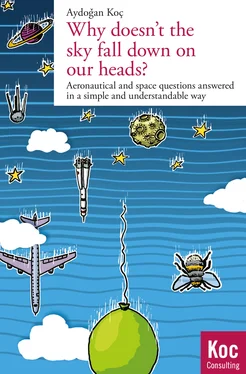Aydogan Koc - Why doesn't the sky fall down on our heads?
Здесь есть возможность читать онлайн «Aydogan Koc - Why doesn't the sky fall down on our heads?» — ознакомительный отрывок электронной книги совершенно бесплатно, а после прочтения отрывка купить полную версию. В некоторых случаях можно слушать аудио, скачать через торрент в формате fb2 и присутствует краткое содержание. Жанр: unrecognised, на немецком языке. Описание произведения, (предисловие) а так же отзывы посетителей доступны на портале библиотеки ЛибКат.
- Название:Why doesn't the sky fall down on our heads?
- Автор:
- Жанр:
- Год:неизвестен
- ISBN:нет данных
- Рейтинг книги:4 / 5. Голосов: 1
-
Избранное:Добавить в избранное
- Отзывы:
-
Ваша оценка:
- 80
- 1
- 2
- 3
- 4
- 5
Why doesn't the sky fall down on our heads?: краткое содержание, описание и аннотация
Предлагаем к чтению аннотацию, описание, краткое содержание или предисловие (зависит от того, что написал сам автор книги «Why doesn't the sky fall down on our heads?»). Если вы не нашли необходимую информацию о книге — напишите в комментариях, мы постараемся отыскать её.
How does lift arise?
What is a Sonic boom?
How does a propeller work?
Why do migratory birds fly in V formations?
Why do airplanes fly so high?
Aerospace is full of mystery!
Aeronautical and space questions answered in a simple and understandable way!
Why doesn't the sky fall down on our heads? — читать онлайн ознакомительный отрывок
Ниже представлен текст книги, разбитый по страницам. Система сохранения места последней прочитанной страницы, позволяет с удобством читать онлайн бесплатно книгу «Why doesn't the sky fall down on our heads?», без необходимости каждый раз заново искать на чём Вы остановились. Поставьте закладку, и сможете в любой момент перейти на страницу, на которой закончили чтение.
Интервал:
Закладка:
There is only one single force which prevents planets, moons, stars and galaxies from drifting apart: this force is called gravity. It can only be balanced by the centrifugal force which is the result of orbital motion. Consequentially, there is a ballet of celestial bodies in the universe which move around each other in perfect harmony, maintaining their existence thanks to the balance of these forces and, unless this balance is impaired, all these celestial bodies will continue their movements for the next millions or even billions of years. Therefore, chief Vitalstatistix really need not worry about the sky falling down on his head one day.
Maybe we should worry a little. When we consider all the small and large celestial bodies in our solar system, we see that this question is something worth worrying about.
There are millions of large and small meteorites, asteroids and comets other than the known planets and their satellites in our own Solar system. Their orbits easily change when they collide with other bodies or due to gravity when they get too close to other planets and stars. As a result, there is a small risk of colliding with the Earth. It is known that many celestial bodies have fallen onto the Earth as a result of these encounters.
For example, it has been proven that a meteorite hit the Mexican gulf about 65 million years ago. It is estimated that this event turned living conditions on Earth upside down and probably caused the extinction of dinosaurs. The magnitude of the damage to be caused by collision of a celestial body with the Earth depends on the size of the celestial body. The main criterion is whether the average diameter exceeds about 30 m, since these celestial bodies need to pass through the gas layer around us called the atmosphere at a very high speed to reach the surface of the Earth. During this transition, many celestial objects burn to ashes or hit the ground in tiny pieces due to increased frictional heat. The large objects can indeed pose a risk to life on Earth. That is why the focus is on rather large celestial objects. Asteroids and meteorites, with an average diameter of a few kilometers, are closely monitored as soon as they are identified. Luckily, there is no immediate risk to the Earth. The probability that a meteorite with an average diameter of 1 km will hit the Earth is estimated to be once in about 300,000 years. However, not all of the small asteroids are being monitored yet, and the probability to collide with one of them is slightly higher. Therefore, it is theoretically possible that this kind of celestial body can cause a small disaster after hitting an inhabited area on the Earth.
Vitalstatistix, thus, needs to think about taking appropriate safety measures in advance. Scientists already have some ideas.
We don't really need to live in continuous anxiety. The probability of other natural disasters seems to be higher than the collision with an asteroid. As you know, when Vitalstatistix encounters a problem, he always summons two of his best men: the fat Obelix and his cunning friend Asterix. This reassuring attitude is also being taken by the international space community; the first French artificial satellite to be launched with a Diamant-A rocket on 26 November, 1965 was called Asterix.
1. The History of Aviation

When was the first flight in human history?
Let's go back to one of the most popular stories of the Ancient days, the story of the inventor and craftsman Daedalus. A slave on the Crete Island, Daedalus constructed a building for King Midas called the Labyrinth. Looking for ways to escape with his son, Icarus, Daedalus came up with a new idea. He would build large wings for Icarus and himself by combining the feathers of an eagle with wax and then they would fly to freedom.
Daedalus was anxious about the flight as he knew the Sun would melt the wax. Thus, he warned his son not to get too close to the Sun. Overwhelmed by the giddiness of flying; Icarus soured into the sky and then came to close to the Sun which melted the wax. His father's warning became sad truth; Icarus plunged into the sea and was killed. Thus, aviation had its first fatality.
Since then, human beings watched birds and flying creatures with great fascination and slight envy and tried to imitate them. Humans studied, tried, failed but did not give up.
The person who probably designed the first flying machine in the 15th century was a scientist and artist, Leonardo da Vinci. A century later, Francesco di Terzi started to sketch the first lighter than air ships. But humanity had to wait for more than another century for construction of an actual flying machine.
The first man-made flying machine flew on 21 November, 1783. The hot air balloon constructed by the Montgolfier brothers rose into the French sky. A few days later on 1 December, 1783, a French Physics Professor, Alexandre Charles, managed to fly with a hydrogen filled balloon.
When was the first airlift used for ´human transport built?
Paris, the capital of France, was besieged by the Germans in 1870. Paris lost all contact with the rest of France. The people of Paris, looking for a way to send messages to other cities, decided to use manned balloons. For the first time, on 23 September, 1870, Jules Darouf managed to fly over the German lines with his balloon. Jules crossed the occupation lines and landed on independent French territory three hours later.
The second aviator who crossed the enemy lines with his balloon was Gaston Tissandier. He too managed to go beyond the lines unobserved. A new age started in the transportation of messages and cargo. However, using balloons to go beyond enemy lines started to lose its initial surprise effect; the Germans started to shoot at the balloons in the sky. After a while, it was only possible to make flights at night. The world's first airlift completed more than 60 balloon flights. More than 9 tons of cargo and 155 passengers were brought to safety outside Paris. It was a huge success, although some of the balloons arrived in the Netherlands; one even landed in Norway.
When was the first controlled flight independent of the wind direction?
The first controlled and guidable flying machine was the glider constructed by Otto Lilienthal in 1891. He flew for more than 250 m starting from a hill in Derwitz, Berlin. He lost his life in a failed attempt in 1896, but his experience answered many questions and paved the way for future generations in aviation. Finally, Wilbur and Orville Wright performed the first powered flight near Kitty Hawk, North Carolina in the USA on 17 December, 1903.
After this successful experience, the excitement of powered flight spread quickly to the entire world. Governments, private entities and individuals organized big prize competitions to introduce aviation to the public and advance the technology of powered flight.
Louis Blériot flew from France to England over the English Channel on 25 July, 1909 with the Blériot XI built by him. The aircraft had a very modern appearance; the engine and the propeller were in the front, the pilot cabin was right behind them and the flight control surfaces were at the rear. In the first aircraft built by the Wright brothers, the control surfaces were in the front, the pilot was in a horizontal position on the body and the engine was at the rear driving two propellers.
When did aircraft begin to be used for military purposes?
Military aircraft began service in 1911 for some countries in the world. Naturally, they were very different from today’s warplanes, the first missions executed with these aircraft were to take military photographs and replace the unreliable balloons and zeppelins being used for this purpose.
Читать дальшеИнтервал:
Закладка:
Похожие книги на «Why doesn't the sky fall down on our heads?»
Представляем Вашему вниманию похожие книги на «Why doesn't the sky fall down on our heads?» списком для выбора. Мы отобрали схожую по названию и смыслу литературу в надежде предоставить читателям больше вариантов отыскать новые, интересные, ещё непрочитанные произведения.
Обсуждение, отзывы о книге «Why doesn't the sky fall down on our heads?» и просто собственные мнения читателей. Оставьте ваши комментарии, напишите, что Вы думаете о произведении, его смысле или главных героях. Укажите что конкретно понравилось, а что нет, и почему Вы так считаете.












